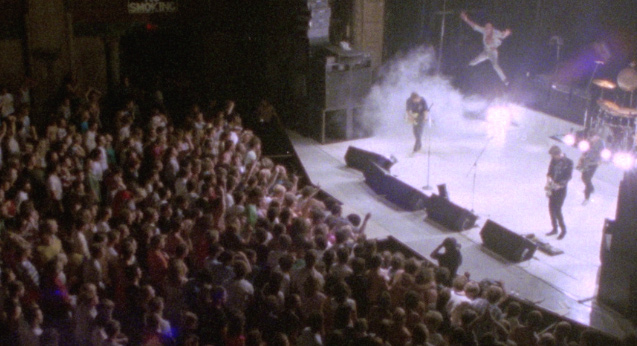Interview: Midnight Oil 1984 director Ray Argall on a film decades in the making

As one of the greatest and most influential Australian bands in history, Midnight Oil needs no introduction. It’s about time the many Midnight Oil fans out there got a proper, feature-length documentary to rock out to.
Enter Midnight Oil 1984, from director Ray Argall. This new film (now in cinemas) chronicles a crucial year in the life of the band, after the release of their album Red Sails in the Sunset. It also captures the first attempt at a political career from frontman Peter Garrett. The week that Midnight Oil 1984 arrives in Australian cinemas, Flicks sat down with Argall, to talk about a film that’s been decades in the making.
This film is about Midnight Oil in the 1980s. Why did it take so long for you to finish it?
There’s two parts to that. The first part is about technology. We shot on neg (negative film) and you can’t actually do anything with neg – neg was like our raw master. Then we’d make a 16mm work print copy that we sync up with the sound, then edit on a Steenbeck editing machine. That’s how we used to have to do it. But this costs quite a bit of money and we didn’t have the resources at that point.
The other key thing is that Midnight Oil had recorded all the music at the Hordern Pavilion. They did six nights in a row and recorded it all on a dance multi-track. They weren’t happy with the performances, and they are pretty fussy. If you listen to Capitol Theatre or any of the live performances they’ve put out, they’re very good. They shelved those multi-tracks. Even though the film I was doing was broader than the concert film, that’s what the original thinking was behind it all.
Most audiences will surely watch the finished product and think: this film sounds great, and looks great!
The technology’s come around. We had to restore all the quarter inch tapes, because they were starting to shed and lose their emulsion. There was a lot of work there, getting them across to the digital format and syncing them up. But then once you get them onto it, you’re talking about high definition, 2k scans and captures and so forth.
On the music side we used a whole lot of sources. There’s a lot of work in that soundtrack, bringing in the various sources of the music. There’s a little bit from the Hordern. But most of it comes from a whole range of sources, including our own desk mixes that we recorded during the tours. I was filming with Midnight Oil in 83, 84 and a little into 85 as well.

Clearly the band invested a lot of faith into you. How did you earn Midnight Oil’s trust?
It’s important to understand that it’s a show and they’re putting it on for an audience. A lot of camera people would just shove their cameras in, and be disrespectful of those boundaries. You have to earn your stripes. You have to earn your respect from the road crew. I had quite a lot of time to do that and that was really important. You need to know where you can go, where you can be out of the way, and also where you can get really good angles to capture significant moments.
How much footage did you up working with?
I had probably 14 or 15 hours of raw material from the 1984 Red Sails tour. But there’s probably another few hours in other materials that I had. I had the Dead Heart film clip that I worked on, including my rushes from that as well. I was able to access all the original cuts.
That’s the same with a lot of the other material I’d shot. For example, we did a series called Pop Movie, in 85 and 86 – a TV series for high school kids about the rock and roll industry. We had a range of presenters talking on that, because the 80s was a really happening time for Australian music, and by association Australian film. As filmmakers there was a lot of us doing music video, including Richard Lowenstein, Sue Davis and many others.

What other concert documentaries inspired you?
There are many, but the one that was really inspiring, in many ways, was Ron Howard’s 8 Days A Week – the Beatles doco. They’d done a lot of restoration of footage and sound. It was really focused on one, relatively small era of the Beatles, and yet it was such a rich film that had such a strong story.
My experience in drama was valuable, how you sort of stitch together a story. Just trying, from an audience point of view, to have a beginning, a middle and an end. Those sort of things are really important. The film was a long time in editing, which in hindsight was fantastic. I was doing other stuff at the same time. So I’d come back fresh, after a couple of months, and really work on trying to bring those story elements together.
The film features interviews with all band members. What kind of access did you get from the band and what kind of conditions, if any, were attached?
There were no conditions written down at all. There was, I guess, a two-way sense of respect. The guys came in at different stages – not all together in one big hit – at rough cut stage. They got the feeling of what was there. On the whole the feedback was really good. It actually helped to flesh out some of the elements. It helped us build and strength some of the storylines.
Find tickets and times to Midnight Oil 1984
















